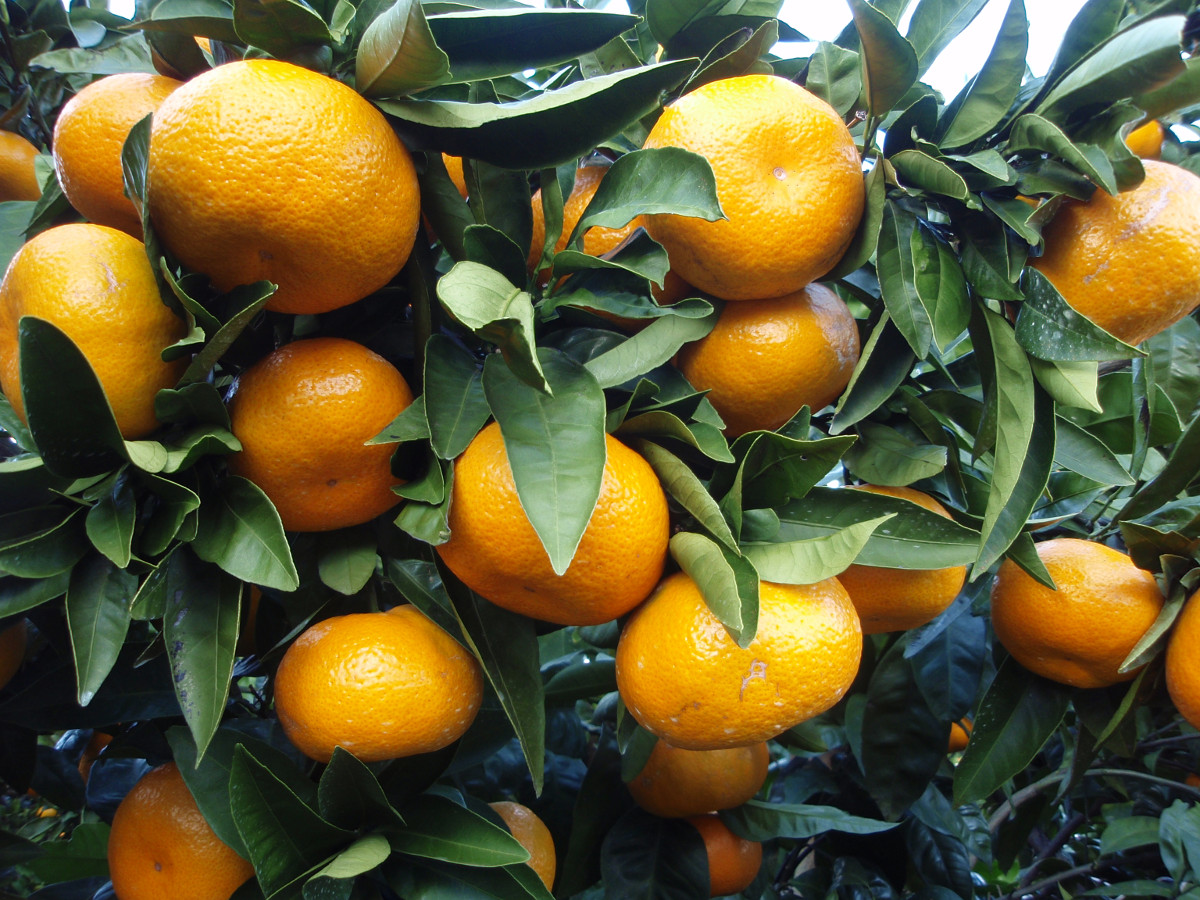Citrus unshiu Marcow. - syn.Citrus nobilis var. unshiu Swingle; Citrus reticulata subsp. unshiu (Marcow.) D. Rivera et al. - Rutaceae
温州蜜柑 unshū mikan (jap.), Satsuma mandarin, Satsuma orange, Satsuma (Mandarine), Kernlose Mandarine
„Its fruit is sweet and usually seedless, about the size of other mandarin oranges (Citrus reticulata), smaller than an orange. One of the distinguishing features of the satsuma is the thin, leathery skin dotted with large and prominent oil glands, which is lightly attached around the fruit, enabling it to be peeled very easily in comparison to other citrus fruits. The satsuma also has particularly delicate flesh, which cannot withstand the effects of careless handling.“ wikipedia
Major constituents found in the absolute of C.unshiu flowers were linalool (2.1%), α-terpineol (0.7%), 2-phenyethanol (5.1%), cis-jasmone (0.4%), benzyl cyanide (4.7%), methyl anthranilate (2.0 %), farnesol (7.2%), indole (0.3 %), and methyl oleate (0.2%). Other compounds contributing to the greenish-fruity and somewhat pungent but also floral sweet odor were (Z)-3-hexenyl acetate, farnesyl acetate, geranylacetone, phenylacetaldehyde, phenylacetaldoxime, sabinene hydrate, methyl benzoate, ethyl benzoate, benzaldehyde, n-nonanal, 6-methyl-5-hepten-2-one, 4-terpinenol, 1-hexanol, (Z)-3-hexenol, geraniol, vanillin, citronellol, elemol, and jasmonic acid.
[Sakurai, Kazutoshi, et al. „Odorous constituents of the absolute from flower of Citrus unshiu Marcovitch.“ Agricultural and Biological Chemistry 43.1 (1979): 195-197] PDF
„The volatile composition of the headspace from Citrus unshiu Marcov. forma Miyagawa-wase blossom was investigated. The volatile constituents were absorbed by a solid-phase microextraction (SPME) fiber and directly transferred to a GC-MS… p-Cymene (23.3%) was the most abundant component in the headspace of fresh C. unshiu blossom; γ-terpinene was the most abundant in shade- and microwave-dried samples (26.8 and 31.2%, respectively) and β-caryophyllene (10.5%) in freeze-dried sample.“
[Characterization of Citrus unshiu (C. unshiu Marcov. forma Miyagawa-wase) blossom aroma by solid-phase microextraction in conjunction with an electronic nose., Choi, H.S., Journal of agricultural and food chemistry, Vol.51(2), 2003, 418-423]
Main flower volatiles were 2-hexenal (tr-2.8%), α-pinene (tr-2.8%), β-pinene (2.9-6.5%), myrcene (0-2.5%), p-cymene (0-8.5%), limonene (0-1.6%), β-ocimene (2.2-6.3%), γ-terpinene (tr-13.7%), linalool (17.4-22.7%), α-terpineol (1.0-5.5%), cis-carveol (tr-1%), α-thujenal (tr-1.3%), β-elemene (2.1-5.4%), caryophyllene (0-2.6%), α-bergamotene (0-4%), β-sesquiphellandrene (0-6.4%), farnesol (tr-1%), Z-jasmone (tr-1.4%), α,p-dimethylstyrene (0-2.1%), phenylacetonitrile (1.2-3.4%), indole (3.6-5%), methyl anthranilate (1.1-17.9%), and (E)-8-heptadecene (tr-1.2%).
[Azam, M., Song, M., Fan, F., Zhang, B., Xu, Y., Xu, C., & Chen, K. (2013). Comparative analysis of flower volatiles from nine Citrus at three blooming stages. International journal of molecular sciences, 14(11), 22346-22367] PDF
Analysis of the flower scent with SPME/GC-MS showed linalool (67.2%), myrcene (5.6%), nerolidol (5.1%), methyl anthranilate (4.7%), 2-aminobenzaldehyde (1.5%), 3,7-dimethyl-1,5-octadien-3,7-diol (1.4%), phenylacetonitrile (1.1%), 6-methyl-5-hepten-2-one (0.7%), phenyl ethanol (0.5%), limonene (0.5%), and indole (0.4%) as main components.
[Ham, D. Y., & Seung-Ho, K. O. (2018). U.S. Patent Application No. 15/548,867]
„Fruit aroma of Guoqing 1, Miyagawa Wase, and Owari from three different Satsuma mandarin varieties were investigated by headspace solid phase microextraction (HS-SPME) combined with GC-MS… The key aroma components were limonene, linalool, γ-terpinene, β-myrcene, α-pinene, and octanal in the three fruits. Guoqing 1 contained more key aroma compounds than Miyagawa Wase and Owari.“
[Study on aroma components in fruit from three different Satsuma mandarin varieties., Qiao, Y., Xie, B.J., Zhang, Y., Zhou, H.Y., Pan, S.Y., Agricultural Sciences in China, Vol.6(12), 2007, 1487-1493]
An aroma extract dilution analysis (AEDA) of the polar fractions of Satsuma mandarin peel oil identified five odorants in common as the most odor-active volatiles: (Z)-hex-3-enal, decanal, linalool, yuzuol, and (2E)-trans-4,5-epoxydec-2-enal. Six odor-active compounds were identified in the non-polar fraction: α-pinene (terpenic and woody), myrcene (pungent and woody), limonene (terpenic and woody), γ-terpinene (woody and terpenic), (3E,5Z)-1,3,5-undecatriene (balsamic and fruity), and (3E,5Z,8Z)-1,3,5,8-undecatetraene (balsamic and fruity).
[Aroma character impact compounds in Kinokuni mandarin orange (Citrus kinokuni) compared with Satsuma mandarin orange (Citrus unshiu)., Miyazawa, N., Fujita, A., Kubota, K., Bioscience, biotechnology, and biochemistry, Vol.74(4), 2010, 835-842] PDF

